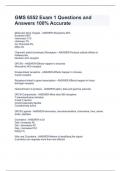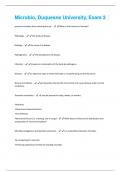Samenvatting
Uitgebreide samenvatting van meerdere hoofdstukken
Een samenvatting gemaakt a.d.h.v. het boek, meerdere plaatjes en tabellen uit het boek gehaald om een zo duidelijk mogelijk overzicht te creëren. De hoofdstukken die hierin worden omschreven zijn 14, 15, 16, 20, 21, 23, 24 en 25
[Meer zien]














